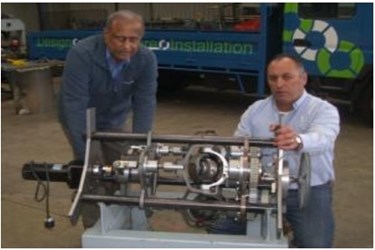New Zealand Based Transmission Developer Attracts Overseas Interest

Developer Gyro Technologies Ltd. has received proposals from centres of excellence in the USA and the UK to develop its unique wind power transmission system.
New Zealand transmission developer Gyro Technologies Ltd. has received proposals from centres of excellence in the USA and the UK to develop its unique wind power transmission system.
Gyroscopic Variable Transmission (GVT), the brainchild of New Zealander Mr Jega Jegatheeson is designed to make wind and wave power more efficient and cost effective. GVT recently featured in a new book, “Innovation in Wind Turbine Design”, by Glasgow-based wind expert Peter Jamieson who described it as “being on the leading edge of wind power technology”.
Agreements have been signed with Narec Capital in the UK and a US consortium of Texas Tech University Department of Mechanical Engineering and renewable energy development company Group NIRE. GTL has issued new shares to raise $500k for local development work, support for the US and UK initiatives and to maintain their patents.
“We are delighted to announce our joint venture with Gyro Technologies Ltd on the commercialisation of their gyroscopic variable transmission (GVT) concept.” said Jerry Biggs, CEO of Narec Capital. “As we move further towards a low carbon economy, the requirement for improvements in the reliability and efficiency of wind turbines is paramount in order that generating costs can become comparable to that of fossil fuels”. ”Narec Capital considers many technologies that may help to improve the efficiency of wind turbines but GVT stood out as a potentially ground breaking concept. Replacing the gearbox of conventional wind turbine systems with GVT should help us to achieve better reliability, flexibility in operating terrain and improvements in overall turbine efficiency. Our goal is now to take this from conceptual design to proof of concept, utilising our in house engineering expertise and commercial incubation process”.
Professor Siva Parameswaran of Texas University adds, “It is becoming evident that the gear system in a wind turbine fails within 10 years (instead of the ideal 20 year life of the turbine) and replacement and associated downtime is very costly. Initial studies performed at the CFD laboratory at Texas Tech University confirm that GVT is a promising technology to keep the Wind Turbine transmission system running for 20 years. Designing a GVT system for a 660 kW Wind turbine is underway at the Department of Mechanical Engineering. Group NIRE and CFD Laboratory are actively involved in seeking funding from potential investors.
In addition to Group NIRE, the CEO of NextraTEC, Dr. Carsten Westergaard (Former Director of Global Technology at Vestas) is interested in applying for Phase I of Small business Technology Transfer (STRR) funding with Computational Fluid Dynamis (CFD) Laboratory to study the market potential of GVT technology.
“We are very positive about our link with Gyro Technologies as we think GVT could be the ideal way to transmit power from a wind turbine to the generator”, said Professor Parameswaran
Mr Jegatheeson, previously an engineer with the former Electricity Corporation of New Zealand, has worked for over 15 years to solve the problems faced by the wind power industry of gearboxes breaking as a result of the massive wind gust forces they are subjected to.
“It’s widely recognised in the industry that the wind turbine gearboxes cannot stand up to the incessant forces over time and many fail within as little as five to seven years. The costs of repairs and also downtime are very significant and alternatives such as direct drive create other expensive problems,” says Mr Jegatheeson.
“Unlike traditional wind turbine gearboxes around the world, GVT technology doesn’t rely on gears and expensive electronics. It instead uses gyroscopic reaction forces to transfer the power from the blades to the generator at variable speed ratio with less stress on the turbine. This will significantly reduce costs – possibly as much as 50% compared to existing systems.” “Wind power is growing at a phenomenal rate worldwide and it would be nice if a New Zealand invention could be powering wind turbines of the future.”
“We are currently raising funds to support the development of GVT at National Energy Centre in U.K. and Texas University in U.S. New shares have been issued towards this end. In the past we were looking to build a large GVT transmission and test it in a full size working wind turbine. A major New Zealand power company offered us a turbine for the trial, but the problem, as always, was funding. Unable to find a suitable partner and support in New Zealand we have had to look overseas. That’s the reality of developing such challenging technologies in a small country,” says Mr Jegatheeson.
Source: NZ Manufacturer Magazine
